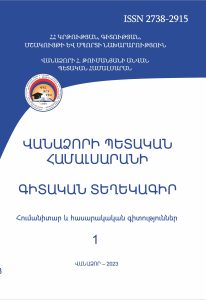Discontinuity of Three-Component Verbal Phrasal Units
Scientific Proceedings of Vanadzor State University Humanitarian and Social Sciences (ISSN 2738-2915)
2023 vol 1
Discontinuity of Three-Component Verbal Phrasal Units
Albert Poghosyan
Summary
 Key words: one-word, polyword, classification by quantity, classification by syntactic ratio, proportionate and disproportionate, participial structure
Key words: one-word, polyword, classification by quantity, classification by syntactic ratio, proportionate and disproportionate, participial structure
Discontinuity has become material of study in recent years. Before now interjections and introductory words, phrases and sentences have been largely studied, but the discontinuity of phrasal units hasn’t been studied yet.
The constant dependence of components is the most common type of dependence among substantive phraseological units. The complete constancy of the components is by no means a mandatory feature of phraseological units. If a variant appears, the constant dependence can turn into a constant-variant one. Phraseological variants are identical in quality and quantity of meanings, as well as in stylistic and syntactic functions. If phraseological units with partially substituted components have the same number of meanings, but they do not completely coincide, differing in shade, figurativeness, stylistic orientation, the structural synonyms are formed. If the number of meanings does not match, with a partially different lexical composition, with a different figurative basis, even if there is a common meaning, it is not possible to talk about phraseological variation or structural synonymy. Such turns should be considered as independent phraseological units.
In this article, we will consider discontinuity of three-component verbal phrasal units in two main ways: according to the principle of quantitative attribute and syntactic relation.
Discontinuity of three-component verbal phrasal units often occurs with one interval. These may be one-word or polyword, which may or may not be members of the sentence. Discontinuity can perform the role of main and secondary members in the sentence.
Phrasal units are rare with two intervals. In this case, intervals can be one-word or polyword, doing or not doing the position of a sentence member.
